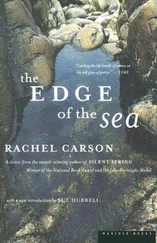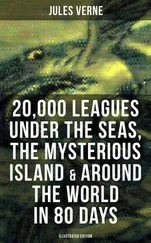
All rights reserved under International and Pan-American Copyright Conventions. By payment of the required fees, you have been granted the non-exclusive, non-transferable right to access and read the text of this ebook onscreen. No part of this text may be reproduced, transmitted, downloaded, decompiled, reverse engineered, or stored in or introduced into any information storage and retrieval system, in any form or by any means, whether electronic or mechanical, now known or hereinafter invented, without the express written permission of the publisher.
The editors of the following magazines have kindly given permission to reproduce material which originally appeared in the pages of their periodicals: Atlantic Naturalist , Nature Magazine , The New Yorker , Science Digest , and The Yale Review .
copyright © 1950, 1951, 1961 by Rachel L. Carson, renewed 1979 by Roger Christie
cover design by Jim Tierney
ISBN: 978-1-4532-1476-3
This edition published in 2011 by Open Road Integrated Media
180 Varick Street
New York, NY 10014
www.openroadmedia.com

For this special edition of The Sea Around Us, Rachel Carson’s notes have been placed at the end of each corresponding chapter.
Our concept of the age of the earth is constantly undergoing revision as older and older rocks are discovered and as methods of study are refined. The oldest rocks now known in North America are in the Canadian Shield area. Their precise age has not been determined, but some from Manitoba and Ontario are believed to have been formed about 3 billion years ago. Even older rocks have been discovered in the Karelia Peninsula in the U.S.S.R., and in South Africa. Geologists are generally of the opinion that present concepts of geologic time will be considerably lengthened in the future. Tentative adjustments of the length of the various periods have already been made (see chart above) and the age of the Cambrian has been pushed back 100 million years compared with the dating assigned to it a decade ago. It is in that immense and shadowy time that preceded the Cambrian, however, that the greatest uncertainty exists. This is the time of the pre-fossiliferous rocks. Whatever life may have inhabited the earth during that time has left few traces, although by indirect evidence we may infer that life existed in some abundance before its record was written in the rocks.
By studies of the rocks themselves geologists have established a few good benchmarks standing out in those vast stretches of time indicated on the chart as the Proterozoic and Archeozoic Eras. These indicate a billion-year age for the ancient Grenville Mountains of eastern North America. Where these rocks are exposed at the surface, as in Ontario, they contain large amounts of graphite, giving silent testimony to the abundance of plant life when these rocks were forming, for plants are a common source of carbon. An age-reading of 1,700,000,000 years has been obtained in the Penokean Mountains of Minnesota and Ontario, formerly known to geologists as the Killarney Mountains. The remains of these once lofty mountains are still to be seen as low, rolling hills. The discovery of even older rocks in Canada, Russia, and Africa, dating back more than 3 billion years, suggests that the earth itself may have been formed about 4½ billion years ago.
From The Condor, vol. 36, no. 5, Sept.–Oct. 1934, pp. 186–7.
From Charles Darwin’s Diary of the Voyage of H.M.S. Beagle, edited by Nora Barlow, 1934 edition, Cambridge University Press, p. 107.
From The Mirror of the Sea, Kent edition, 1925, Doubleday-Page, p. 71.
From The Depths of the Ocean, by Sir John Murray and Johan Hjort, 1912 edition, Macmillan & Co., p. 649.
Even today the mystery of the scattering layer has not been completely revolved. Through an ingenious combination of new techniques, however, the picture is gradually becoming clearer. It now appears that at least in some areas—as over the continental shelf off New England—fishes may compose a substantial part of the layer. This has been determined by studying it with a sound source that embraces many frequencies (the ordinary echo sounder is a single-frequency device). This method not only reveals the vertical migration but brings out the fact that the very nature of the scattering changes with depth. Such changes are best interpreted as originating in the swim bladders of fishes, which are compressed under the increasing pressure of a descent into deeper levels of the sea but which expand with ascent toward the surface and consequent lessening of pressure. The formerly held objection that fishes could not possibly be abundant enough to account for the very widespread occurrence of the scattering layer has melted away in the light of information new techniques have given us. It was formerly supposed that a strong echo implied a very dense concentration of whatever creatures were returning the echo. Now it is realized that the tracings recorded by the echo sounder do not necessarily indicate the density of the animals in the scattering layer, so that actually a dark tracing on the record may be produced by only a few strong scatterers passing through the beam in any particular instant of time.
One of the study methods increasingly used during the 1950’s was an underwater camera correlated with an echo sounder. All pictures of fishes so obtained have been accompanied by strong echoes. None of these findings rule out the possibility that other organisms may also help to compose the scattering layer. They do furnish rather convincing evidence that fishes compose an important part of a phenomenon that, in all probability, lends itself to no single explanation, but varies as to the species composing it over the vast areas of the ocean.
In 1957 Bruce C. Heezen of the Lamont Geological Observatory published a fascinating compilation of fourteen instances of whales entangled in submarine cables between 1877 and 1955. Ten of these accidents occurred off the Pacific coast of Central and South America, two in the South Atlantic, one in the North Atlantic, and one in the Persian Gulf. All entanglements involved sperm whales and it is possible the concentration of reports off the coasts of Ecuador and Peru may be related to a seasonal migration of these whales. The greatest depth at which a whale was found entangled was 620 fathoms or nearly two-thirds of a mile. More whales were trapped by cables at about 500 fathoms than at any other depth, suggesting that the natural food of the sperm whale may be concentrated at about this level. Two significant details were observed in most of these cases: the entanglement occurred near the site of earlier repairs where slack cable lay on the bottom, and the cable was usually wrapped around the whale’s jaw. Heezen suggests that as a whale skims along the ocean bottom in search of food its lower jaw may become entangled in a slack loop of cable lying on the bottom. The struggles of the whale to free itself could easily result in its complete entanglement in the cable.
For years people have speculated as to the function served by sound production on the part of marine species. It has been known for at least 20 years that the bat finds its way about in lightless caves and on dark nights by means of a physiological equivalent of radar, emitting a stream of high-frequency sound, which returns to it as echoes from any obstructions in its path. Could the sounds produced by certain fishes and marine mammals serve a similar purpose, aiding inhabitants of deep waters to swim in darkness and to find prey? Among the early tape recordings of underwater sound obtained by the Woods Hole Oceanographic Institution was a recording of some mysterious calls that emanated from waters so deep as surely to be lightless. They were distinguished by the fact that each call was followed by a faint echo of itself, so that for want of a better name the unknown author of these eerie sounds was christened the “echo fish.” Actual evidence of anything similar to the bat’s echo location or echo ranging has come only recently in the form of ingenious experiments performed on captive porpoises by W. N. Kellogg of Florida State University. Dr. Kellogg finds that the porpoises emit streams of underwater sound pulses by which they are able to swim accurately through a field of obstructions without collision. They could do this in water too turbid for vision or in darkness. When the experimenters introduced any object into the tank the porpoises gave forth bursts of sound signals by which the animals appeared to be trying to locate the object. Splashing on the surface, as from a hose or a shower of rain, “produced great disturbance, loud sound signals, undulating porpoise ‘alarm’ whistles, and ‘flight’ swimming reactions.” When food fish were introduced into the tank under such circumstances that they could not be located visually, the porpoises located them by streams of sound signals, turning their heads to right and left as the returning echoes allowed them to fix the exact location of their target.
Читать дальше














